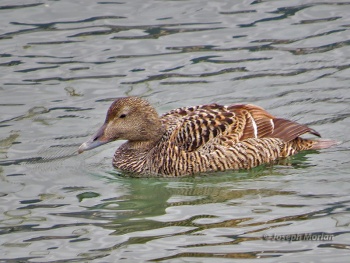
Photo © by Ove Ferling
West Sweden, 31 January 2017
- Somateria mollissima
Identification
50–71 cm (19¾-28 in)
Male: black and white, green nape, pinkish tinge to breast, large wedge-shaped bill.
Female: brown.
Eclipse Male: All dark with variable white on wing coverts and long curved tertials (late June to September).
Distribution
Europe and Asia: The commonest and most widespread of the eiders, breeding across much of the north and extending further south than any other.
Breeds around virtually the whole of Iceland, in the Faroes and around the north of Ireland, most of Scotland and parts of northern England. In Continental Europe breeds in Brittany, the Netherlands, Denmark, Germany and Poland. Has recently bred in Switzerland and northern Italy. Around Scandinavia found on most coasts including the Baltic coasts but absent from the Gulf of Bothnia, and in the Baltic States. To the north breeds on Svalbard, Franz Josef Land and Novaya Zemlya and on the coast of Arctic Russia around the Kola Peninsula and White Sea. There is a small but increasing population far from the main breeding range in the Ukraine. Has bred in Poland and Austria.
Northernmost populations move south in winter but most populations are dispersive rather than migratory and movements are of no great distance.
Range more extensive in winter, found around coasts of southern Britain and northern France and scarce on lakes in Central Europe and in the northern Mediterranean. Vagrant south to the Azores, North Africa and the western Black Sea.
North America: breeding from the Aleutian islands and Alaska, along northern Canada and the Baffin Bay, as well as the east coast of Canada and USA south to Massachusetts, as well as along the southern 3/4 of the coast of Greenland.
In winter vacates the northernmost parts of the range in Alaska and Canada, and can be found a little south of the breeding range in both eastern and western North America, for example annual south to Virginia but rarer than that along the rest of the east coast of USA.
Taxonomy
Subspecies
Six subspecies are recognized[1]:
- Over most of the Western Palearctic, breeding birds belong to the nominate race.
- Those of the Faroes, Shetland and Orkney are faroeensis, smaller, with greyer bill and shorter frontal lobes in male and darker, more heavily barred plumage in female.
- The most northerly breeders in the region, from Iceland, and Greenland to eastern Canada belong to the race borealis with bright orange-yellow bill in male and more rufous plumage in female. Recorded as a vagrant in northern British Isles.
- Race v-nigrum is found in eastern Siberia and western North America; it has a black "V" shaped mark on its throat.
- dresseri from eastern Canada and USA has been reported as a vagrant in Scotland; it has a broader more rounded frontal shield (bill lobe).
- sedentaria is found in central Canada (Hudson Bay).
Habitat
Shallow inshore seas breeding on small islands or undisturbed mainland beaches, on passage and in winter also on estuaries, rarely on inland waters.
Behaviour

Photo © by Christine Fisher
Cape Cod, Massachusetts, USA, 6 September 2009
Breeding
Breeding is often colonial with colonies on small islands. Arrival of Fox (in Europe: Vulpes vulpes) can lead to decimation or eradication of such breeding colonies[2]. About 8% of the eggs laid in 16% of the clutches in high density colonies in Svalbard were from other females. This is an example of intraspecific brood parasitism[3]. The nest is built close to the sea and is lined with eiderdown, plucked from the female's breast.
Diet
The diet includes crustaceans, molluscs, and mussels. Also observed to eat fish
Vocalisation
Vocal between autumn and spring, but generally silent at other times. Males give a haunting cooing call not unlike that of domestic pigeons. Females less vocal but give a series of throaty gog-gog-gog calls.
Common Eider voice clip
References
- Clements, J. F., T. S. Schulenberg, M. J. Iliff, S. M. Billerman, T. A. Fredericks, B. L. Sullivan, and C. L. Wood. 2019. The eBird/Clements Checklist of Birds of the World: v2019. Downloaded from http://www.birds.cornell.edu/clementschecklist/download/
- BirdLife International. 2016. Somateria mollissima. The IUCN Red List of Threatened Species 2016: e.T22680405A92861620. http://dx.doi.org/10.2305/IUCN.UK.2016-3.RLTS.T22680405A92861620.en. Downloaded on 31 August 2018.
- Bjørn, T. H. & Erikstad, K. E. (1994) Patterns of intraspecific nest parasitism in the High Arctic common eider (Somateria mollissima borealis). Canadian Journal of Zoology, 72:1027-1034, https://doi.org/10.1139/z94-139
- Carboneras, C., Christie, D.A., Kirwan, G.M. & Sharpe, C.J. (2018). Common Eider (Somateria mollissima). In: del Hoyo, J., Elliott, A., Sargatal, J., Christie, D.A. & de Juana, E. (eds.). Handbook of the Birds of the World Alive. Lynx Edicions, Barcelona. (retrieved from https://www.hbw.com/node/52914 on 31 August 2018).
- Goudie, R. I., G. J. Robertson, and A. Reed (2000). Common Eider (Somateria mollissima), version 2.0. In The Birds of North America (A. F. Poole and F. B. Gill, Editors). Cornell Lab of Ornithology, Ithaca, NY, USA. https://doi.org/10.2173/bna.546
- Morlan, J. (2009). What, if anything, is "eclipse" plumage. Birding 41(6):50-52.
- Pyle, P. (2008) Identification Guide to North American Birds - Part II. Slate Creek Press, Point Reyes Station, California.
- Todd, F. S. (1979) Waterfowl - Ducks, Geese & Swans of the World. Harcourt Brace Jovanovich, New York & London.
Recommended Citation
- BirdForum Opus contributors. (2024) Common Eider. In: BirdForum, the forum for wild birds and birding. Retrieved 9 November 2024 from https://www.birdforum.net/opus/Common_Eider
External Links
GSearch checked for 2020 platform.1






